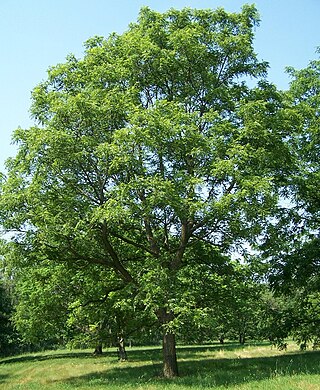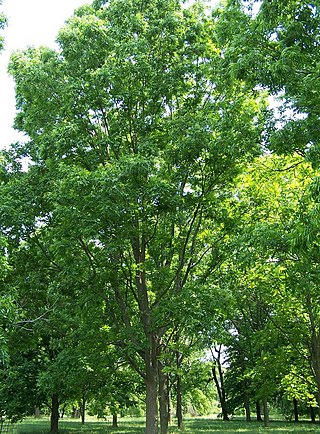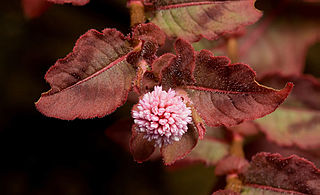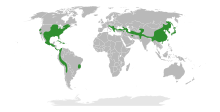
Alders are trees comprising the genus Alnus in the birch family Betulaceae. The genus comprises about 35 species of monoecious trees and shrubs, a few reaching a large size, distributed throughout the north temperate zone with a few species extending into Central America, as well as the northern and southern Andes.

The Fagales are an order of flowering plants, including some of the best-known trees. The order name is derived from genus Fagus, beeches. They belong among the rosid group of dicotyledons. The families and genera currently included are as follows:
Family is one of the eight major hierarchical taxonomic ranks in Linnaean taxonomy. It is classified between order and genus. A family may be divided into subfamilies, which are intermediate ranks between the ranks of family and genus. The official family names are Latin in origin; however, popular names are often used: for example, walnut trees and hickory trees belong to the family Juglandaceae, but that family is commonly referred to as the "walnut family".

The Mimosoideae are a traditional subfamily of trees, herbs, lianas, and shrubs in the pea family (Fabaceae) that mostly grow in tropical and subtropical climates. They are typically characterized by having radially symmetric flowers, with petals that are twice divided (valvate) in bud and with numerous showy, prominent stamens.

Walnut trees are any species of tree in the plant genus Juglans, the type genus of the family Juglandaceae, the seeds of which are referred to as walnuts. All species are deciduous trees, 10–40 metres (33–131 ft) tall, with pinnate leaves 200–900 millimetres (7.9–35.4 in), with 5–25 leaflets; the shoots have chambered pith, a character shared with the wingnuts (Pterocarya), but not the hickories (Carya) in the same family.

The pecan is a species of hickory native to the southern United States and northern Mexico in the region of the Mississippi River. The tree is cultivated for its seed in the southern United States, primarily in Georgia, New Mexico, Texas, and Mexico, which produces nearly half of the world total. The seed is an edible nut used as a snack and in various recipes, such as praline candy and pecan pie. The pecan is the state nut of Alabama, Arkansas, California, and Texas and is also the state tree of Texas.

Persicaria is a genus of herbaceous flowering plants in the knotweed family, Polygonaceae. Plants of the genus are known commonly as knotweeds or smartweeds. It has a cosmopolitan distribution, with species occurring nearly worldwide. The genus was segregated from Polygonum.

A nut is a fruit consisting of a hard or tough nutshell protecting a kernel which is usually edible. In general usage and in a culinary sense, a wide variety of dry seeds are called nuts, but in a botanical context "nut" implies that the shell does not open to release the seed (indehiscent).

The Juglandaceae are a plant family known as the walnut family. They are trees, or sometimes shrubs, in the order Fagales. Members of this family are native to the Americas, Eurasia, and Southeast Asia.

Hickory is a common name for trees composing the genus Carya, which includes around 18 species. Five or six species are native to China, Indochina, and India (Assam), as many as twelve are native to the United States, four are found in Mexico, and two to four are native to Canada. A number of hickory species are used for products like edible nuts or wood.

Pterocarya, often called wingnuts in English, are trees in the walnut family Juglandaceae. They are native to Asia. The botanic name is from Ancient Greek πτερον (pteron) "wing" + κάρυον (karyon) "nut".

Juglans nigra, the eastern American black walnut, is a species of deciduous tree in the walnut family, Juglandaceae, native to North America. It grows mostly in riparian zones, from southern Ontario, west to southeast South Dakota, south to Georgia, northern Florida and southwest to central Texas. Wild trees in the upper Ottawa Valley may be an isolated native population or may have derived from planted trees.

Juglandeae is a tribe of the Juglandoideae subfamily, in the Juglandaceae family.
Annamocarya is a genus of flowering plants in the family Juglandaceae, containing only one species, Annamocarya sinensis, native to southwestern China and northern Vietnam. It is related to the hickories, and was formerly included in the same genus Carya, as Carya sinensis, but also shares a number of characteristics with the walnuts in the genus Juglans. It is grouped with Carya in the subtribe Caryinae. It is sometimes called Chinese hickory or beaked hickory.
The APG III system of flowering plant classification is the third version of a modern, mostly molecular-based, system of plant taxonomy being developed by the Angiosperm Phylogeny Group (APG). Published in 2009, it was superseded in 2016 by a further revision, the APG IV system.

Caryinae is a subtribe of the tribe Juglandeae subfamily in the Juglandaceae.

Juglandinae is a subtribe of the Juglandeae tribe, of the Juglandoideae subfamily, in the Juglandaceae family. Walnut tree species make up the genus Juglans, which belongs to the subtribe Juglandinae.

Carya pallida, sand hickory, or pale hickory is a species of hickory native to the southeastern United States. It is a perennial, dicotyledonous plant which prefers rocky or sandy habitats. The sand hickory can reach heights of up to 30m, but its typical height is between 9-24m. In an open area, Carya crowns are usually towering and slim. The sand hickory nut is edible and consumed by various organisms.













